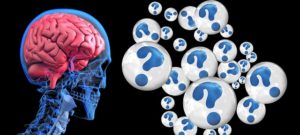Playlist
Show Playlist
Hide Playlist
Information-Processing Model – Cognition (PSY)
-
Slides Cognition MakingSenseOfTheEnvironment.pdf
-
Download Lecture Overview
00:01 Okay, let’s talk about cognition, more specifically how we process the information once it actually enters our mind. 00:08 So we’re going to go through a couple of models and take a look at what that looks like. 00:12 So, we’re going to look at some information processing models and this is what happens when a stimulus enters the brain. 00:18 So, we know when we engage with the environment and our world, information is coming in through the somatosensory process. 00:24 That’s covered in another module, but the point is information is coming in. 00:28 Once it comes in, we need to go through a couple of steps. 00:31 So, the first step is the attention. 00:34 We have to draw attention to the fact that something is coming in. 00:37 And then we have the perception of what is going on. 00:39 And then ultimately, we’re going to have storage into memory. 00:42 So, going through each of those steps, there’s a lot that needs to be done in order to understand what it is that we’ve just engaged with. 00:50 So our minds can be compared to computers and that they change, store, use and retrieve information, right? So we’ve used that analogy before because it makes a lot of sense. 00:59 So, the Alan Baddeley model attempted to better define short-term memory, renaming it to working memory. 01:04 And so, that’s not to say that it replaces short-term memory, but we have something called working memory. 01:10 So, in the memory section that we’ve done prior to this, we have talked about the fact that working memory is something that gets input from both short-term memory and long-term memory, and is used in terms of accomplishing or achieving a task. 01:25 So, included in working memory we have the phonological loop, which is where we repeat verbal information -- phone numbers, a list, an address, an email address. 01:35 We have visuospatial sketchpad, where we use mental images and redraw what we though we saw. 01:40 We have episodic buffer, where the working memory interacts with the long-term memory and it’s basically drawing from episodic experiences that we’ve had previously. 01:52 Then we have the central executive, which is basically the conductor and it oversees the process, mediates attention, and decides where is that we’re going to focus our attention. 02:01 So this was Alan Baddeley’s Working Memory Model. 02:07 So we have all the different components that we basically talked about. 02:11 So there’s language. 02:11 So you can see here on the bottom, we have language, visual semantics, and short-term episodic memory, and that feeds into or is run by things like the phonological loop, the visuospatial sketchpad, episodic buffer, and all these things feed into our central executive, which manages what it is that we’re actually doing. 02:29 The end result of all of this stuff is that we’re drawing on information that we have in our memory, we use some of the tools that we have at our disposal in a bin called working memory to answer or achieve a task run by the central executive.
About the Lecture
The lecture Information-Processing Model – Cognition (PSY) by Tarry Ahuja, PhD is from the course Making Sense of the Environment.
Included Quiz Questions
Jane is trying to remember all the items on her grocery list. What is one method of remembering the items?
- Phonological loop
- Episodic buffer
- Cognitive executive
- Implicit memory
- Personal memory
Customer reviews
5,0 of 5 stars
| 5 Stars |
|
5 |
| 4 Stars |
|
0 |
| 3 Stars |
|
0 |
| 2 Stars |
|
0 |
| 1 Star |
|
0 |




